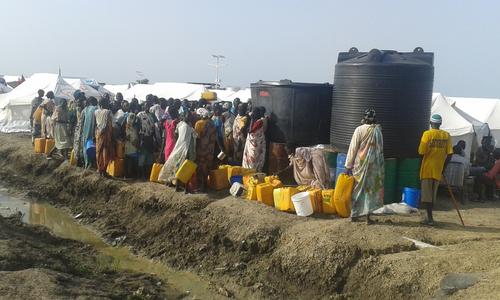Paul Jawor, MSF’s water and sanitation technical adviser shares his findings
In your role as technical adviser on water and sanitation issues, you go to Médecins Sans Frontières (MSF) projects and solve water-related problems. When you were in Melut in South Sudan’s Upper Nile state what problems did you encounter?
Melut is one of the flashpoints in the current escalation of fighting in South Sudan. MSF has a hospital in a displaced person’s camp called Denthoma 1, which currently hosts 20,000 people. When fighting broke out in Melut in mid-May, MSF was forced to suspend its medical activities and evacuate the team. This meant that the population did not have access to much needed healthcare at a critical time. One week later, MSF staff arrived for a four-day “flash visit” and found that the hospital and nearby pharmacies had been looted and vandalised. In addition, the only system providing clean drinking water to the people in the camp had stopped working and some of the water tanks had bullet holes in them.
Denthoma 1 is on the banks of the Nile, and when the full MSF team returned to the camp they found that people had been drinking river water for three days. MSF distributed water purification packets to every family so that they could purify the river water before drinking it. I was immediately sent to Melut to assess the situation and solve the problem.
What was the state of the water supply when you arrived in Melut?
The first thing I noticed was that there were lots of bullet holes in several of the water tanks, so we knew we had to patch those – easy to assess and with an easy solution. We then tested the water system and it worked for a while, but then the water stopped flowing. We checked the valves and discovered that they were blocked, so we decided to dismantle the system. The tools in the warehouse had been stolen when the hospital was looted, so we started rummaging around the camp and found a giant spanner. With that, and a few tools from the car toolkit, we began to take the system apart.
What did you discover after you took the system apart?
We opened up every valve, put our hands inside and found crushed plastic from water bottles stuck in the valve opening. This was what was blocking the water flow. How it got there is a mystery. It took us a day to open every valve and remove the plastic.
Is the system working now?
We ran the pump and it worked, but as the water was flowing through the system and filling up the tanks we saw water streaming out like a fountain and discovered that more than 10 of the main tanks had bullet holes in them. We plugged some of the holes with plastic bags as a temporary measure, while others were patched using supplies from a rubber repair kit. All of them will be repaired properly once we get the water flowing.
We successfully re-established a water supply for 20,000 people, so that each person can continue to get their 10 litres of water a day. The people in Denthoma 1 are no longer drinking untreated river water and putting their lives at risk from water-borne diseases such as diarrhoea and cholera.
Now that the problem in Melut is solved, I’m off to the next emergency water call!



